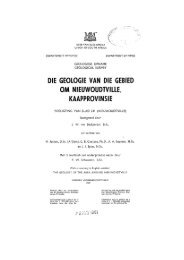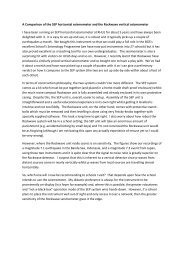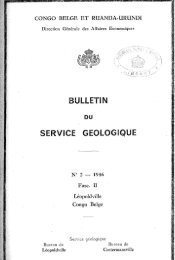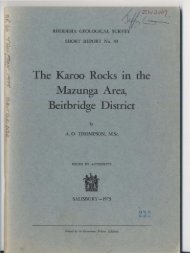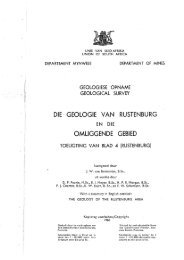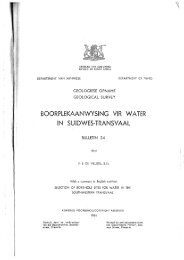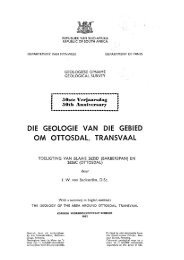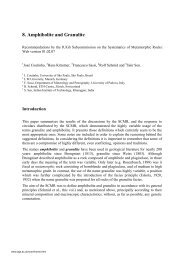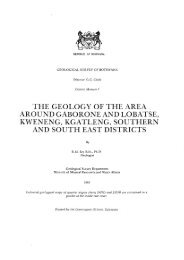Bibliography - British Geological Survey
Bibliography - British Geological Survey
Bibliography - British Geological Survey
Create successful ePaper yourself
Turn your PDF publications into a flip-book with our unique Google optimized e-Paper software.
monographs (1911‒March 1913) describing the first complete Neanderthal skeleton from La Chapelle-aux-<br />
Saints. Thus Teilhard’s remark may have had no relevance to the discoveries at Piltdown.)<br />
Teilhard de Chardin, P. 1920. Le cas de l’homme de Piltdown. Revue des questions scientifiques, 77,<br />
149–155. (This paper presents Teilhard’s only published statement on Piltdown. He regards the skull as<br />
being older than Neanderthal but essentially that of an advanced human, whereas the jaw belongs to a fossil<br />
ape, and thus he supposes that the skull and jaw must belong to two different creatures.)<br />
Teilhard de Chardin, P. 1952. On the zoological position and the evolutionary significance of<br />
Australopithecines. Transactions of the New York Academy of Sciences, 14 (5), 208‒210. (After 1920,<br />
Teilhard for the most part ignored the evidence of Piltdown in his discussion of fossil man. Interestingly, he<br />
chooses in this paper to show ‘Eo’ (for Eoanthropus) as middle Pleistocene in an evolutionary diagram, but<br />
goes no further than this notation.)<br />
Teilhard de Chardin, P. 1965. Lettres d’Hastings et de Paris, 1908–1914. Paris: Aubier éditeur, 463 pp.<br />
(Letters to his parents written during his time in the seminary at Hastings, and touching on his activities at<br />
Piltdown. A translation of some of these letters into English was published by Herder and Herder, New<br />
York, 1967 and 1968. See also translated correspondence in Spencer 1990b.)<br />
Teilhard de Chardin, P. 1967. Letters from Paris, 1912‒1914. New York : Herder and Herder, 157 pp.<br />
Translated by Michael Mazzarese.<br />
Teilhard de Chardin, P. 1968. Letters from Hastings, 1908‒1912. New York : Herder and Herder, 206 pp.<br />
Translated by Judith de Stefano.<br />
Teilhard de Chardin, P. (for Teilhard’s views immediately following the first announcement of the<br />
Piltdown forgery, see Anon. 1953d, and correspondence in Spencer 1990b)<br />
Thacker, A. G. 1913a (see Buttel-Reepen 1913)<br />
Thacker, A. G. 1913b. The significance of the Piltdown discovery. Science Progress, 8, no. 30, 275–290.<br />
Thacker, A. G. 1916. [Note on Miller 1915]. Science Progress, 10, 468.<br />
Thackeray, J. 1992. On the Piltdown joker and accomplice: a French connection? Current Anthropology,<br />
33 (5), 587–589. (A response to Tobias’s defence of Teilhard de Chardin, ibid., 33, 244)<br />
Thackeray, J. 2011. On Piltdown: the possible roles of Teilhard de Chardin, Martin Hinton and Charles<br />
Dawson. Transactions of the Royal Society of South Africa, 66 (1), 9–13.<br />
Thackeray, J. 2012. Deceiver, joker or innocent ? Teilhard de Chardin and Piltdown Man. Antiquity, 86,<br />
228–234. (See note under Teilhard de Chardin 1913)<br />
Thieme, F. P. 1986. Stephen Jay Gould, Pierre Teilhard de Chardin and Piltdown revisited. American<br />
Journal of Physical Anthropology, 69 (2), 271.<br />
Thieme, F. P. 1988. Book review: [Blinderman, The Piltdown Inquest]. American Anthropologist, 90, 170–<br />
171.<br />
Thomas, H. 2002. Le mystère de l’homme de Piltdown: une extraordinaire imposture scientifique. Paris:<br />
Belin, 288 pp. (Provides what has been described as perhaps the most objective analysis of the Piltdown<br />
affair. Separate chapters are devoted to a defence of Teilhard de Chardin, Sir Arthur Keith, and Sir Arthur<br />
Conan Doyle.)<br />
Thomas, H. 2003. « Tête » d’imposteur ! Historia, no. 675, 38‒41.<br />
Thompson, L. 1986. Qui a fabriqué l’homme de Piltdown? L’Histoire, no. 88, 94‒96.<br />
Thomson, K. S. 1991a. Piltdown Man: the great English mystery story. American Scientist, 79, 194–201.<br />
(After reviewing the evidence in the Piltdown affair, the writer finds himself favourably inclined to the<br />
‘devilishly ingenious scheme’ put forward in 1980 by Leonard Harrison Matthews, which he thinks explains<br />
nearly all of the anomalies and motives, but with a few modifications in order to make it ‘the perfect English<br />
crime.’ Unlike Matthews, he sees Dawson as the sole instigator. Thus, Dawson begins by luring Samuel<br />
Woodhead, Lewis Abbott and Teilhard de Chardin into his plot with a cock-and-bull story of workmen



